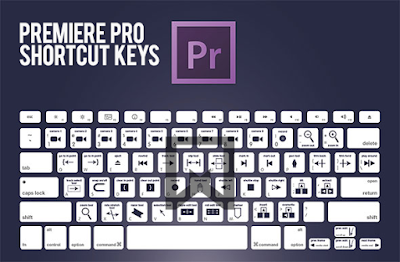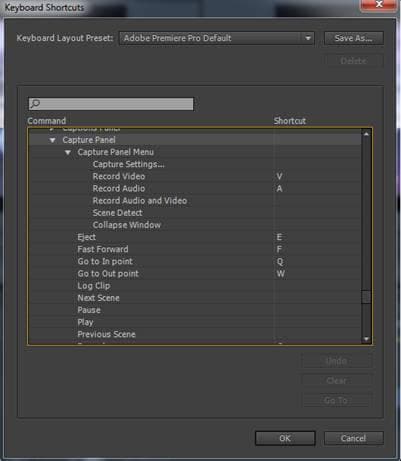Adobe Premiere Pro Cc Shortcuts Mac
Cover image via
Premiere Pro CC features additional helpful keyboard shortcuts. This is a list of Timeline Shortcuts that will speed up your video editing and let you work smarter.
Go to the File menu (or Premiere Pro CC menu on Mac) and choose Keyboard Shortcuts Keyboard Layout Preset Adobe Premiere Pro Default if it isn’t already selected. To expand and minimize your timeline tracks, use Shift+=/ –. Ctrl+=/ – (Cmd+=/ –) handles only video track height, and Alt+=/ – (Opt+=/ –) only audio track height. In addition, Adobe Premiere Pro CC has added a lot of shortcuts to the Default keyboard settings, which saves you the time of adding them individually. To clarify keyboard shortcuts: Mac users have Command & Option, PC users have Control & Alt. The following shortcuts are written with Command & Option.
Adobe Premiere Pro Mac Cracked
I previously looked at time saving tips in Premiere Pro CS6here and here. In addition, Adobe Premiere Pro CC has added a lot of shortcuts to the Default keyboard settings, which saves you the time of adding them individually.
To clarify keyboard shortcuts: Mac users have Command & Option, PC users have Control & Alt. The following shortcuts are written with Command & Option. Simply sub these keys out for Control & Alt on a PC.
All the Default Shortcuts for Premiere Pro CC are listed here.Let’s dive into some of the must know timeline shortcuts for Premiere Pro CC:
Toggle Audio Scrub:
Shift + SSometimes you want to hear audio when you scrub, sometimes you don’t. Turning off scrubbing increases processing power.
Toggle Trim Type:
Control + T (Shift on PC)Toggles between standard trim (leaves a gap), ripple and roll.
Ripple Trim:
Next Edit – W , Previous Edit – QLets you trim the head or tail of a clip, a quick way to work.
Slip Clip in Sequence:
Option+ Command + left/right keys
Add Shift to move 5 framesChanges the in and out points of the clip in the Premiere Pro timeline. Note, it doesn’t change the length of the clip.
Slide Clip in Sequence:
Option + , (left) or Option +. (right)
Add Shift to move 5 framesLooks at 3 clips, slides the middle clip left or right. Thehe clips to the left/right adjust in length (the middle clip stays the same length).
Add keyframes to Opacity/Volume:
Command Click with Selection ToolThis is quicker than switching to the pen tool to add keyframes and then switching back to the selection tool. If you don’t see the white line for opacity/volume, go to the wrench (Timeline Display Settings) and select “Show Video Keyframes” or “Show Audio Keyframes”.
Nudge (move a clip up or down):
Up or Down ArrowsHold Alt/Option to select just video or audio (or click the linked selection button), then use the up or down arrow. This will add tracks if they don’t already exist (similar to the FCP behavior)
Nest:
No Default (I use Option + C)
Shift + T reveals clips in nestSelect the clips you want to Nest, then press Option + C. Name the Nest a specific, useful name. Do not use the defaults. If I then wanted to step into the Nest I created, Shift + T will show me the original clips. I previously covered Nesting here.Edit Clip in Audition:
No Default (I use Shift + A)You can right click on a clip to do this, but I use this a lot and this is quicker. This is a round-trip, in that you make your changes in Audition and they show up back in Premiere Pro. I have written on this in more detail here.
Replace with After Effects Comp:
No Default (I use Shift + E)You can also right click on a clip to this, but again I use this often and this Premiere Pro CC shortcut quicker. This is also a round-trip, in that you make your changes in After Effects and they show up back in Premiere Pro. Use this when you need to just send a clip to After Effects for something that cant be done in Premiere Pro (like Motion Tracking). If this is new to you, check the Adobe Help for more info.
Group Clips:
Command + GSelect the clips you want to group and press Command + G. When you click on a clip in a group, they all turn grey (selected). Grouping allows you to move multiple clips as one clip.
Some things to know about Groups in Premiere Pro:
– If you click on the edge of a clip, it trims just that clip.
– If you select the group first, clocking on an edge trims the group
– Grouping will let you swap edit multiple clips as one clip.Add Edit:
Command + K (for targeted tracks)Similar to using the Razor Tool, but it cuts tracks that are targeted (will cut all tracks that are targeted). To view your add edits in a Sequence, click the wrench icon and select “Show Through Edits”.
Replace with Clip from Source:
No Default (I use Shift + R)Replace Edits looks at where the playheads are in the Source & Sequence (ignoring the In and Out). I have a video tutorial on this here for more detail.
Add Default Transitions to Selection:
Shift + DThis will apply the default transition to all selected clips. This shortcut now applies the transition to all clips. It didn’t work on the first and last clip in Premiere Pro CS6.
Do you have Premiere Pro shortcuts that you can’t live without?
Share your favorite Premiere shortcuts in the comments below!
Speed up your editing by relying on your keyboard. If you memorize these 16 keyboard shortcuts, you’ll become a true workflow warrior.
Editors are always looking for ways to work faster. Keyboard shortcuts are a great way to do this. When you can perform a series of edits without even touching your mouse, you speed up your workflow. I love learning keyboard shortcuts — it familiarizes me with a program’s functionality and improves my speed.
So I’ve rounded up 16 keyboard shortcuts you should start using today. Some you may know, and some you may not, but all of them will increase your command of Adobe Premiere Pro.
1,2, & 3. Shuttling Controls (J,K, and L)
One of the more basic Premiere shortcuts, the J, K, and L shuttle controls are standard across most NLEs. They let you play forward with L, play in reverse with J, and pause with K. Press the keys multiple times to shuttle more quickly through your timeline.
4. Maximize Panel Size (`, Backtick)
This button simply expands the selected panel size to full screen. This is incredibly handy when you want to get a full screen preview of your timeline.
5. Add Edit (Cmd/Ctrl + K)
This is one of my favorite shortcuts. To me, it’s much faster than pulling out the razor tool for every edit.
For an even easier time with this shortcut, assign it to one of your mouse’s side buttons (if it has any) for immediate cuts in a flash. Add a shift modifier, and it will cut all clips under the playhead.
6 & 7. In and Out (I & O)
Probably one of the most used shortcuts in Premiere, this marks in and out points on your selected clip or on your timeline.
8 & 9. Clip Shuttling (Up+Down Keys)
These are, by far, the best keys to use to get through your edits. The up key will shuttle you through your timeline edit points, getting you where you want to go as quickly as possible. Select which layer you want to shuttle through by toggling the V and A markers.
10 & 11. Timeline Expansion and Minimization (+ & -)
The + and – keys are pivotal for getting a good look at your timeline. Using them on their own, they will either stretch or condense your timeline horizontally. With added ctrl/cmd modifiers, you can stretch your timeline vertically to get a better look at each individual clip
12. Paste Attributes (Ctrl/Cmd+Alt+V)
The paste attributes shortcut isn’t one you’ll use often, but it’s a great way to paste over attributes such as motion or Lumetri color settings from one clip to another.
13. Match Frame (F)

Use the match frame shortcut to bring the selected clip into your preview window at the playhead on your timeline.
14. Selecting Individual Clips (Alt+Click)
Yes, this shortcut may use the mouse, but it is still very useful. When you select a clip, Premiere defaults to selecting the audio as well. With alt+click, you can select just the audio layer to delete any scratch tracks you may have used for syncing.
15. Undo (Ctrl/Cmd+Z)
This shortcut is pretty universal. When you make the wrong edit, and you want to revert back, just smash the undo button until you get back to the edit you want.



16. Selection Tool (V)
Adobe Premiere Pro Keyboard Shortcuts Mac
The “stasis” key in Premiere is a good shortcut when you’re working with titles or other tools. When you want to revert back to your selection tool, just press V.
A Handy Shortcut Guide
If you want to keep all these shortcuts within reach, here’s a handy chart:
Looking for more video production tips and tricks? Check out these articles.
